1950 FIFA World Cup
| IV Campeonato Mundial de Futebol | |
|---|---|
 1950 FIFA World Cup official logo |
|
| Tournament details | |
| Host country | |
| Dates | 24 June – 16 July |
| Teams | 13 (from 3 confederations) |
| Venue(s) | 6 (in 6 host cities) |
| Final positions | |
| Champions | |
| Runner-up | |
| Third place | |
| Fourth place | |
| Tournament statistics | |
| Matches played | 22 |
| Goals scored | 88 (4 per match) |
| Attendance | 1,036,000 (47,091 per match) |
| Top scorer(s) | |
|
← 1938
1954 →
|
|
The 1950 FIFA World Cup, held in Brazil from 24 June to 16 July, was the fourth FIFA World Cup. It was the first World Cup since 1938, the planned 1942 and 1946 competitions having been canceled owing to World War II.
Brazil was chosen as the host country by FIFA in July 1946. It was also the first tournament where the trophy was referred to as the Jules Rimet Cup, to mark the 25th anniversary of Rimet's presidency of FIFA. It was won by Uruguay, who had won the inaugural competition in 1930, clinching the cup by beating the hosts Brazil 2–1 in the deciding match of the four-team final group (this was the only tournament not decided by a one-match final).
Contents |
Background
Because of World War II, the World Cup had not been staged since 1938; the planned World Cups of 1942 and 1946 were both cancelled. After the war, FIFA were keen to resurrect the competition as soon as possible, and they began making plans for a World Cup tournament to take place. In the aftermath of the war, much of Europe lay in ruins. As a result, FIFA had some difficulties finding a country interested in hosting the event, since many governments believed that the world scenario did not favour a sportive celebration, and also (more importantly) that the resources that would have to be put into organizing the World Cup could not be diverted from other more urgent fronts.
For some time, the World Cup was at risk of not being held for sheer lack of interest from the international community, until Brazil presented a bid at the 1946 FIFA Congress, offering to host the event on condition that the tournament take place in 1950 (it was originally planned to take place in 1949).[1] Brazil and Germany had been the leading bidders to host the cancelled 1942 World Cup; since both the 1934 and 1938 tournaments had been held in Europe, football historians generally agree that the 1942 event would most likely have been awarded to a South American host country. Brazil's new bid was very similar to the mooted 1942 bid and was quickly accepted.
Qualification

Having secured a host nation, FIFA would still dedicate some time to persuading countries to send their national teams to compete. Italy was of particular interest: the Italians were the long-standing defending champions (winners in 1934 and 1938). However, Italy's national team was weakened severely as most of its starting lineup perished in the Superga air disaster one year before the start of the tournament. The Italians were eventually persuaded to attend, but traveled by boat rather than by plane.[2]
Banned teams
Both Germany (still occupied and partitioned) and Japan (still occupied) had not been permitted to compete for qualification --- this was the only World Cup finals tournament for which Germany failed to qualify. Italy and Austria, on the other hand, were not subject to international sanctions, and Italy qualified automatically as defending champions. The French-occupied Saarland had been accepted by FIFA two weeks before the World Cup, several months before the German Football Association (DFB) was reinstated, while Soviet-occupied East Germany had not yet founded a football association.
British nations
The British nations were invited to take part, having rejoined FIFA four years earlier, after 17 years of self-imposed exile. It was decided to use the 1949-1950 British Home Championship as a qualifying group, with the top two teams qualifying. England finished first and Scotland second.
Withdrawals before qualification
A number of teams refused to participate in the qualifying tournament, including most nations behind the Iron Curtain, such as the USSR, 1938 finalists Hungary and 1934 finalists Czechoslovakia.[2]
Withdrawals during qualification
Argentina, Ecuador and Peru in South America withdrew after the qualifying draw (in Argentina's case because of a dispute with the Brazilian Football Association). This meant that Chile, Bolivia, Paraguay and Uruguay qualified from South America by default.[2] In Asia, the Phillippines, Indonesia and Burma all withdrew, leaving India to qualify by default. In Europe, Austria withdrew, claiming its team was too inexperienced.[2] Belgium also withdrew from the qualification tournament.[2] These withdrawals meant that Switzerland and Turkey qualified without having to play their final round of matches.
Withdrawals after qualification, before the draw
Before the qualification competition, George Graham, chairman of the Scottish Football Association (SFA), had said that Scotland would only travel to Brazil as winners of the Home Championship.[3] (England, by contrast, had committed to attending, even if they finished in second place).[3] After Scotland ended up in second place behind England, the Scottish captain George Young, encouraged by England captain Billy Wright, pleaded with the SFA to change its mind and accept the place in Brazil: however Graham refused to change his position and so Scotland withdrew from the tournament.[3]
Turkey also withdrew, citing financial problems and the cost of travelling to South America.[4] FIFA invited Portugal and France, who had both been eliminated in qualifying, to fill the gaps left by Scotland and Turkey. Portugal refused, but France initially accepted, and was entered into the draw
Draw and subsequent withdrawals
The draw, held in Rio on 22 May, 1950, allocated the fifteen remaining teams into four groups:[5]
- Group 1: Brazil, Mexico, Switzerland and Yugoslavia
- Group 2: England, Chile, Spain and the USA
- Group 3: Italy, India, Paraguay and Sweden
- Group 4: Uruguay, Bolivia and France
However, India subsequently withdrew when FIFA imposed a rule banning barefoot play (India had caused a scandal by playing barefoot at the 1948 Olympics)[6][7](some reports suggest that the withdrawal was also because of the expense of travelling to Brazil [8]). France withdrew because of the amount of travel that would be required in Group 4. There was not enough time to invite further replacement teams or to reorganize the groups, so the tournament featured only thirteen teams, with just two nations in Group 4,.
Of the thirteen teams that competed, only one, England, was making its debut. Several of the South and Central American teams were competing for the first time since the inaugural 1930 tournament -- this included undefeated Uruguay, as well as Mexico, Chile, Paraguay and Bolivia. Yugoslavia was also making its first appearance since 1930. This would be the USA's last appearance at the World Cup finals until 1990.
Summary
Format
The Brazilian organizers of the tournament proposed a new format in which the 16 teams be divided into four first round groups (or "pools" as they were then called) of four teams, with the group winners advancing to a final group stage, playing in round-robin format to determine the winner. The main reason for this choice was money: the organizers had spent a great deal on stadium and infrastructure investment. A straight knockout tournament, as had been used in 1934 and 1938, would feature only sixteen games (including the third-place playoff), while the proposed two-group format would guarantee thirty games, and thus more ticket revenue.[9] In addition, this format would guarantee each team at least three games, and thus provide more incentive for European teams to make the journey to South America and compete.[9] FIFA originally resisted this proposal, but backed down after Brazil threatened to back out of hosting the tournament if this format was not used.[9]
The entire tournament was arranged in such a way that the four first round groups had no geographical basis. Hence, several teams were obliged to cover large distances to complete their program, although Brazil was allowed to play two of its three group matches in Rio de Janeiro while its other game was in (comparatively) nearby São Paulo.
Results
A combined Great Britain team had recently beaten the rest of Europe 6-1 in an exhibition match and England went into the competition as one of the favourites. However, it was not to be, as they went crashing out on 29 June in a shock 1-0 defeat by the United States (when the score appeared in English newspapers, many thought it was a misprint) which, combined with their 1-0 defeat by Spain, led to England being eliminated. Italy, the defending champions, lost their unbeaten record at the World Cup finals when the team was defeated 3-2 by Sweden in its opening match. Because of this defeat, Italy failed to progress to the second round.
The final group stage involved the teams who won their groups: Brazil, Spain, Sweden, and 1930 FIFA World Cup champions Uruguay, who were making their first World Cup appearance since winning the inaugural tournament. The World Cup winner would be the team that managed to finish on top of this group. The final group's six matches were shared between Rio de Janeiro and São Paulo. Brazil played all its final group matches at the Estádio do Maracanã in Rio while the games that didn't involve the host nation were played in São Paulo. Brazil won their first two matches with a 7-1 thrashing of Sweden and 6-1 rout of Spain. Before the decisive match, Brazil was sitting on top of the final group and had one game left to play against Uruguay, in second and only a point behind. On July 16, before a huge home crowd of 199,954 (some estimated as 205,000) in the Estádio do Maracanã, the host nation only had to draw against Uruguay and the trophy would be theirs. After such crushing victories over Spain and Sweden, it looked certain they would take the title, especially as the home nation went ahead in the second minute of the second half, thanks to a goal from Friaça. However, Uruguay equalised and then with just over 11 minutes left to play, went ahead 2-1 when Alcides Ghiggia squeaked a goal past Moacyr Barbosa, and Uruguay was crowned World Cup champions for a second time. This stunning defeat surprised Brazil and is referred to as the Maracanazo.
The average attendance of nearly 61,000 per game, aided greatly by eight matches (including five featuring hosts Brazil) held in the newly-built Maracanã, set a record that would not be broken until 1994. Not counting the Maracanã matches, the average attendance was a still-impressive 37,500. However, the only venues that saw crowds comparable to or greater than those in recent World Cups were the Maracanã and São Paulo. Other venues saw considerably smaller crowds.
Venues
Six cities hosted the tournament:
| Rio de Janeiro | São Paulo | Belo Horizonte |
|---|---|---|
| Estádio do Maracanã | Estádio do Pacaembu | Estádio Sete de Setembro |
| Capacity: 200,000 | Capacity: 60,000 | Capacity: 30,000 |
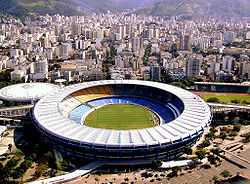 |
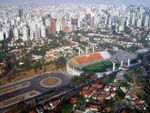 |
|
| Curitiba | Porto Alegre | Recife |
| Estádio Durival de Britto | Estádio dos Eucaliptos | Estádio Ilha do Retiro |
| Capacity: 10,000 | Capacity: 20,000 | Capacity: 10,000 |
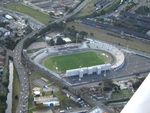 |
||
Squads
For a list of all squads that appeared in the final tournament, see 1950 FIFA World Cup squads.
Seeding
| Pot 1 | Pot 2 | Pot 3 | Pot 4 |
|---|---|---|---|
|
|
Match officials
|
|
Results
First Round
Group 1
| Team | Pld | W | D | L | GF | GA | Pts |
|---|---|---|---|---|---|---|---|
| 3 | 2 | 1 | 0 | 8 | 2 | 5 | |
| 3 | 2 | 0 | 1 | 7 | 3 | 4 | |
| 3 | 1 | 1 | 1 | 4 | 6 | 3 | |
| 3 | 0 | 0 | 3 | 2 | 10 | 0 |
| 24 June 1950 15:00 BRT (UTC-03) |
Brazil |
4 – 0 | Estádio do Maracanã, Rio de Janeiro Attendance: ~81,000 Referee: George Reader (England) |
|
|---|---|---|---|---|
| Ademir Jair Baltazar |
Report |
| 25 June 1950 18:00 BRT (UTC-03) |
Yugoslavia |
3 – 0 | Estádio Independência, Belo Horizonte Attendance: ~8,000 Referee: Giovanni Galeati (Italy) |
|
|---|---|---|---|---|
| Mitić Tomašević Ognjanov |
Report |
| 28 June 1950 15:00 BRT (UTC-03) |
Brazil |
2 – 2 | Estádio do Pacaembu, São Paulo Attendance: ~42,000 Referee: Ramón Azon Roma (Spain) |
|
|---|---|---|---|---|
| Alfredo Baltazar |
Report | Fatton |
| 28 June 1950 18:15 BRT (UTC-03) |
Mexico |
1 – 4 | Estádio dos Eucaliptos, Porto Alegre Attendance: ~11,000 Referee: Reginald Leafe (England) |
|
|---|---|---|---|---|
| Ortiz |
Report | Bobek Ž. Čajkovski Tomašević |
| 1 July 1950 15:00 BRT (UTC-03) |
Brazil |
2 – 0 | Estádio do Maracanã, Rio de Janeiro Attendance: ~142,000 Referee: Benjamin Griffiths (Wales) |
|
|---|---|---|---|---|
| Ademir Zizinho |
Report |
| 2 July 1950 15:40 BRT (UTC-03) |
Mexico |
1 – 2 | Estádio dos Eucaliptos, Porto Alegre Attendance: ~3,500 Referee: Ivan Eklind (Sweden) |
|
|---|---|---|---|---|
| Casarín |
Report | Bader Tamini |
Group 2
| Team | Pld | W | D | L | GF | GA | Pts |
|---|---|---|---|---|---|---|---|
| 3 | 3 | 0 | 0 | 6 | 1 | 6 | |
| 3 | 1 | 0 | 2 | 2 | 2 | 2 | |
| 3 | 1 | 0 | 2 | 5 | 6 | 2 | |
| 3 | 1 | 0 | 2 | 4 | 8 | 2 |
| 25 June 1950 15:00 BRT (UTC-03) |
England |
2 – 0 | Estádio do Maracanã, Rio de Janeiro Attendance: ~30,000 Referee: Karel van der Meer (Netherlands) |
|
|---|---|---|---|---|
| Mortensen Mannion |
Report |
| 25 June 1950 15:00 BRT (UTC-03) |
Spain |
3 – 1 | Estádio Durival de Britto, Curitiba Attendance: ~9,000 Referee: Mario Vianna (Brazil) |
|
|---|---|---|---|---|
| Basora Zarra |
Report | Pariani |
| 29 June 1950 15:00 BRT (UTC-03) |
Spain |
2 – 0 | Estádio do Maracanã, Rio de Janeiro Attendance: ~20,000 Referee: Alberto Malcher (Brazil) |
|
|---|---|---|---|---|
| Basora Zarra |
Report |
| 29 June 1950 18:00 BRT (UTC-03) |
United States |
1 – 0 | Estádio Independência, Belo Horizonte Attendance: ~10,000 Referee: Generoso Datillo (Italy) |
|
|---|---|---|---|---|
| Gaetjens |
Report |
| 2 July 1950 15:00 BRT (UTC-03) |
Spain |
1 – 0 | Estádio do Maracanã, Rio de Janeiro Attendance: ~74,000 Referee: Giovanni Galeati (Italy) |
|
|---|---|---|---|---|
| Zarra |
Report |
| 2 July 1950 18:00 BRT (UTC-03) |
Chile |
5 – 2 | Estádio Ilha do Retiro, Recife Attendance: ~8,000 Referee: Mario Gardelli (Brazil) |
|
|---|---|---|---|---|
| Robledo Cremaschi Prieto |
Report | Wallace Maca |
Group 3
| Team | Pld | W | D | L | GF | GA | Pts | |
|---|---|---|---|---|---|---|---|---|
| 2 | 1 | 1 | 0 | 5 | 4 | 3 | ||
| 2 | 1 | 0 | 1 | 4 | 3 | 2 | ||
| 2 | 0 | 1 | 1 | 2 | 4 | 1 | ||
| withdrew | ||||||||
| 25 June 1950 15:00 BRT (UTC-03) |
Sweden |
3 – 2 | Estádio do Pacaembu, São Paulo Attendance: ~50,000 Referee: Jean Lutz (Switzerland) |
|
|---|---|---|---|---|
| Jeppson Andersson |
Report | Carapellese Muccinelli |
| 29 June 1950 15:30 BRT (UTC-03) |
Sweden |
2 – 2 | Estádio Durival Britto, Curitiba Attendance: ~8,000 Referee: Robert Mitchell (Scotland) |
|
|---|---|---|---|---|
| Sundqvist Palmér |
Report | López López Fretes |
| 2 July 1950 15:00 BRT (UTC-03) |
Italy |
2 – 0 | Estádio do Pacaembu, São Paulo Attendance: ~26,000 Referee: Arthur Ellis (England) |
|
|---|---|---|---|---|
| Carapellese Pandolfini |
Report |
Group 4
| Team | Pld | W | D | L | GF | GA | Pts | |
|---|---|---|---|---|---|---|---|---|
| 1 | 1 | 0 | 0 | 8 | 0 | 2 | ||
| 1 | 0 | 0 | 1 | 0 | 8 | 0 | ||
| withdrew | ||||||||
| 2 July 1950 18:00 BRT (UTC-03) |
Uruguay |
8 – 0 | Estádio Independência, Belo Horizonte Attendance: ~5,000 Referee: George Reader (England) |
|
|---|---|---|---|---|
| Míguez Schiaffino Vidal Pérez Ghiggia |
Report |
Final Round
| Team | Pld | W | D | L | GF | GA | Pts |
|---|---|---|---|---|---|---|---|
| 3 | 2 | 1 | 0 | 7 | 5 | 5 | |
| 3 | 2 | 0 | 1 | 14 | 4 | 4 | |
| 3 | 1 | 0 | 2 | 6 | 11 | 2 | |
| 3 | 0 | 1 | 2 | 4 | 11 | 1 |
| 9 July 1950 15:00 BRT (UTC-03) |
Brazil |
7 – 1 | Estádio do Maracanã, Rio de Janeiro Attendance: ~138,000 Referee: Arthur Ellis (England) |
|
|---|---|---|---|---|
| Ademir Chico Maneca |
Report | Andersson |
| 9 July 1950 15:00 BRT (UTC-03) |
Uruguay |
2 – 2 | Estádio do Pacaembu, São Paulo Attendance: ~44,000 Referee: Benjamin Griffiths (Wales) |
|
|---|---|---|---|---|
| Ghiggia Varela |
Report | Basora |
| 13 July 1950 15:00 BRT (UTC-03) |
Brazil |
6 – 1 | Estádio do Maracanã, Rio de Janeiro Attendance: ~152,000 Referee: Reginald Leafe (England) |
|
|---|---|---|---|---|
| Ademir Jair Chico Zizinho |
Report | Igoa |
| 13 July 1950 15:00 BRT (UTC-03) |
Uruguay |
3 – 2 | Estádio do Pacaembu, São Paulo Attendance: ~8,000 Referee: Giovanni Galeati (Italy) |
|
|---|---|---|---|---|
| Ghiggia Míguez |
Report | Palmér Sundqvist |
| 16 July 1950 15:00 BRT (UTC-03) |
Sweden |
3 – 1 | Estádio do Pacaembu, São Paulo Attendance: ~11,000 Referee: Karel van der Meer (Netherlands) |
|
|---|---|---|---|---|
| Sundqvist Mellberg Palmér |
Report | Zarra |
| 16 July 1950 15:00 BRT (UTC-03) |
Uruguay |
2 – 1 | Estádio do Maracanã, Rio de Janeiro Attendance: ~200,000 Referee: George Reader (England) |
|
|---|---|---|---|---|
| Schiaffino Ghiggia |
Report | Friaça |
Scorers
- 9 goals
.svg.png) Ademir
Ademir
- 5 goals
 Estanislao Basora
Estanislao Basora Oscar Míguez
Oscar Míguez
- 4 goals
.svg.png) Chico
Chico Telmo Zarra
Telmo Zarra Alcides Ghiggia
Alcides Ghiggia
- 3 goals
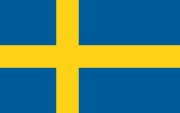 Karl-Erik Palmér
Karl-Erik Palmér Stig Sundqvist
Stig Sundqvist Juan Alberto Schiaffino
Juan Alberto Schiaffino
- 2 goals
|
|
|
- 1 goal
|
|
|
FIFA Retrospective Ranking
In 1986, FIFA published a report that ranked all teams in each World Cup up to and including 1986, based on progress in the competition, overall results and quality of the opposition.[18] The rankings for the 1950 tournament were as follows:
Final group
Eliminated at the first group stage
 Yugoslavia
Yugoslavia Switzerland
Switzerland Italy
Italy England
England Chile
Chile United States
United States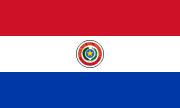 Paraguay
Paraguay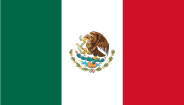 Mexico
Mexico Bolivia
Bolivia
Footnotes
- ↑ Planet World Cup - 1950
- ↑ 2.0 2.1 2.2 2.3 2.4 Lisi (2007), p. 47
- ↑ 3.0 3.1 3.2 http://www.bbc.co.uk/scotland/sportscotland/asportingnation/article/0001/page02.shtml
- ↑ http://www.tff.org/default.aspx?pageID=497
- ↑ Lisi (2007), pp., 48-49
- ↑ Lisi (2007), p. 49
- ↑ "1950 FIFA World Cup Brazil - Overview". FIFA. http://www.fifa.com/worldcup/archive/edition=7/overview.html.
- ↑ "India's football absence examined". BBC. 11 July 2010. http://news.bbc.co.uk/sport2/hi/football/world_cup_2010/8802642.stm.
- ↑ 9.0 9.1 9.2 Lisi (2007), p. 45
- ↑ RSSSF credits the goal in the 30th minute as occurring in the 31st minute.
- ↑ FIFA report credits this goal to Kosta Tomašević; RSSSF and Cris Freddi to Mitic.
- ↑ RSSSF credits this goal as occurring in the 43rd minute.
- ↑ FIFA credits the goal in the 23rd minute as occurring in the 22nd minute.
- ↑ FIFA credit the goal in the 51st minute as occurring in the 62nd minute.
- ↑ RSSSF credits this goal as occurring in the 89th minute.
- ↑ RSSSF credits this goal to Charles Antenen in the 44th minute.
- ↑ RSSSF credits this goal as coming in the 49th minute.
- ↑ http://www.fifa.com/mm/document/afdeveloping/technicaldevp/50/09/00/fwc_mexico_1986_en_part4_279.pdf page 45
Bibliography
- Lisi, Clemente Angelo (2007). A history of the World Cup: 1930-2006. Lanham, MD: Scarecrow Press. ISBN 081085905X. http://books.google.com/books?id=yX3l3vrNZSwC.
External links
- 1950 FIFA World Cup on FIFA.com
- Details at RSSSF; note that they often disagree with FIFA on goal scorers and times
- History of the World Cup-1950
|
||||||||||||||||||||||||||||||||||||||
|
|||||
|
|||||||||||||||||
|
||||||||||||||||||||
|
|||||||||||||||||||||||||||||

